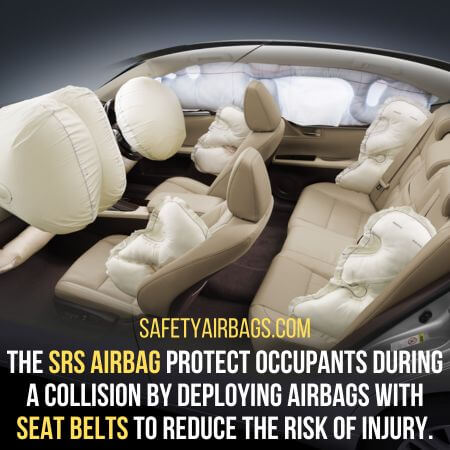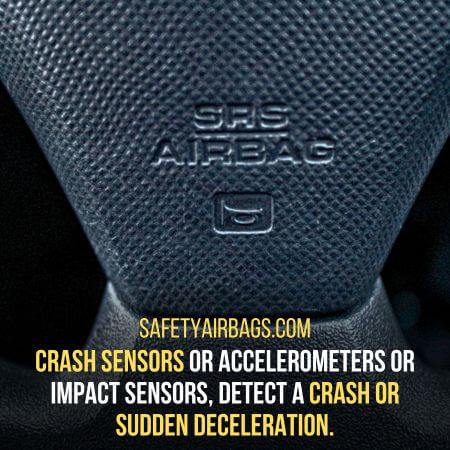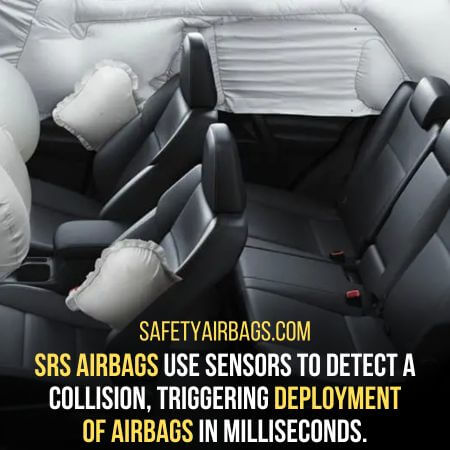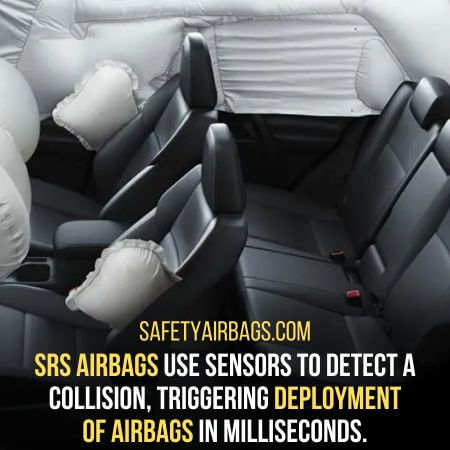What does an SRS airbag mean? SRS stands for “Supplemental Restraint System.”
What Will I learn
The SRS airbag is a safety feature in vehicles designed to provide additional protection to occupants during a collision by deploying airbags with seat belts to reduce the risk of injury.
What does An SRS airbag mean? Let’s Find Out
SRS stands for “Supplemental Restraint System.” The SRS airbag is a critical safety feature in modern vehicles.

It refers to a system that works alongside seat belts to provide additional protection to vehicle occupants during a collision.
The SRS airbag system typically includes various sensors, control units, and strategically placed airbags throughout the vehicle.
In the event of a significant impact or crash, the SRS airbag system detects the collision.
It rapidly deploys the airbags to help cushion and protect the occupants from the impact forces.
The SRS airbag system enhances passenger safety and reduces the risk of severe injuries during accidents.
Evolution of Vehicle Safety Systems
The evolution of vehicle safety systems has been driven by the need to enhance occupant protection.
Early safety measures primarily focused on structural improvements, such as reinforced frames and safety glass.
Additionally, seatbelts were introduced as a significant breakthrough in the 1950s, providing basic restraint during accidents.
Need for advanced safety systems:
With the rise in motor vehicle accidents and their associated injuries, there was an increasing need for more advanced safety systems.
Traditional safety features alone could not address the changing dynamics of modern vehicles and the diversity of collision scenarios.
This led to the development of active and passive safety technologies that could better protect occupants in various crash scenarios.
The introduction of SRS airbags is a significant milestone
The introduction of SRS airbags marked a significant milestone in vehicle safety.
In the late 1960s, engineers began exploring the concept of airbag systems as a means to enhance occupant protection further.
In the early 1970s, the first production vehicles equipped with SRS airbags were introduced.
Since then, the technology has significantly advanced, becoming a standard feature in most modern vehicles.
Understanding SRS Airbags
SRS stands for Supplemental Restraint System, which accurately describes the purpose of these airbags.
They are supplementary to the primary restraint system, i.e., seatbelts, and provide additional protection to occupants during a crash.
Components of SRS airbags
SRS airbag systems consist of several key components working together to detect collisions and deploy the airbags appropriately:
1. Crash sensors:
Crash sensors, also known as accelerometers or impact sensors, are responsible for detecting a crash or sudden deceleration.

These sensors measure the rate of change in the vehicle’s velocity and provide critical data to the airbag control unit.
2. Airbag modules:
Airbag modules include the airbag itself, the inflator, and the housing.
The airbag is typically made of a lightweight and durable fabric that can rapidly inflate upon deployment.
The inflator contains a chemical propellant that triggers a controlled chemical reaction to generate gas and inflate the airbag.
3. Control unit:
The control unit, also known as the electronic control module (ECM) or airbag control module (ACM), is the brain of the SRS airbag system.
It receives data from the crash sensors, analyzes the collision’s severity, and determines whether airbag deployment is necessary.
Modern vehicles often integrate the control unit with other safety systems for efficient coordination.
4. Seatbelt pre-tensioners:
Seatbelt pre-tensioners are mechanisms that retract and tighten the seatbelts during a crash.
They work with SRS airbags to optimize occupant restraint and minimize forward movement, ensuring the occupants remain in the optimal position for airbag deployment.
Types of SRS airbags
SRS airbags are designed to protect occupants in various crash scenarios.
Different types of airbags are strategically placed throughout the vehicle’s interior to offer comprehensive protection.
1. Frontal airbags:
Frontal airbags are the most common type, typically located in the driver’s steering wheel and the front passenger’s dashboard.
These airbags deploy during frontal collisions, protecting the head and chest regions of the occupants.
2. Side airbags:
Side airbags are designed to deploy during side-impact collisions.
They protect the torso and pelvis, reducing the risk of injuries caused by the intrusion of the impacting object into the occupant’s space.
3. Curtain airbags:
Curtain or side curtain airbags are deployed from the roof lining above the side windows.
They protect the occupant’s heads in the event of a side collision, reducing the risk of head injuries and enhancing overall safety.
4. Knee airbags:
Knee airbags are located below the steering column and dashboard.
They deploy to cushion and protect the occupants’ knees during a frontal collision, reducing the risk of lower leg and knee injuries.
5. Rear-seat airbags:
Rear-seat airbags are designed to protect rear passengers during rear-end collisions.
These airbags are typically integrated into the rear seatbacks or side panels, offering additional protection to occupants in the back seats.
Functioning of SRS Airbags
SRS airbags function by using sensors to detect a collision, triggering the deployment of airbags within milliseconds.

The airbags rapidly inflate to cushion, reducing the risk of severe injuries to vehicle occupants during a crash.
Triggering Mechanisms:
The triggering mechanisms of SRS airbags are primarily based on sensors and control units.
These systems use various sensors, such as accelerometers, crash sensors, and seat occupancy sensors, to detect and assess the severity and type of impact.
The control unit continuously monitors the sensor inputs and determines if airbag deployment is necessary.
When a collision is detected, the control unit sends an electrical signal to the airbag inflator containing chemical fuel.
The inflator ignites the fuel, causing a rapid gas generation that inflates the airbag within milliseconds.
The triggering mechanisms ensure that the airbags deploy quickly and effectively to protect the vehicle occupants.
Crash sensors and their role in detecting impact
Crash sensors play a vital role in detecting the impact or collision.
These sensors are strategically placed throughout the vehicle and measure the acceleration or deceleration of the vehicle.
When a collision occurs, the sensors detect the sudden change in velocity and send signals to the airbag control unit.
Criteria for airbag deployment
The airbag control unit analyzes the data received from the crash sensors and determines whether the collision meets the criteria for airbag deployment.
Deployment process:
During a crash, the deployment process of SRS airbags follows a specific sequence of events.
Once the airbag control unit determines that deployment is necessary, an electric current is sent to the inflator, igniting a chemical reaction.
This reaction generates a controlled amount of gas, inflating the airbag within milliseconds.
Collaborative systems:
SRS airbags work collaboratively with seatbelts to optimize occupant protection.
Seatbelt pre-tensioners tighten the seatbelts to minimize occupant movement during a crash, ensuring the occupants are in the proper position for airbag deployment.
The combined use of seatbelts and airbags enhances the overall effectiveness of occupant restraint and reduces the risk of injuries.
Integration with other safety features (e.g., stability control)
SRS airbags are often integrated with other advanced safety features in modern vehicles.
For example, they work with electronic stability control systems to optimize vehicle stability and control during emergency maneuvers.
This integration ensures a coordinated response to different crash scenarios, enhancing overall vehicle safety.
Benefits and Limitations of SRS Airbags
The benefits of SRS airbags include reducing the risk of severe injuries during collisions.
It also means enhancing occupant protection when used with seat belts and providing an additional layer of safety.
Limitations include potential injury risks from airbag deployment, the need for proper maintenance, and potential limitations in certain collision scenarios.
1. Reduction of occupant injuries:
The primary benefit of SRS airbags is the reduction of occupant injuries during collisions.
By rapidly deploying and forming a cushioning barrier, airbags help absorb the impact forces, minimizing the risk of severe head, chest, and upper body injuries.
They provide additional protection to seatbelts, enhancing overall occupant safety.
2. Prevention of fatal injuries:
SRS airbags have played a significant role in preventing fatal injuries in vehicle crashes.

Their ability to reduce the severity of impact forces on the occupants’ bodies has saved numerous lives.
Airbags have effectively prevented fatalities by minimizing the risk of severe head trauma and chest injuries.
3. Integration with other safety systems:
SRS airbag systems are often integrated with other vehicle safety systems.
It involves Collision avoidance systems, Pedestrian Detection, and Lane departure warning systems.
The integration allows for coordinated responses during emergencies.
It optimizes the effectiveness of safety measures and providing comprehensive protection to vehicle occupants.
4. Collision avoidance systems:
SRS airbags can be integrated with collision avoidance systems, such as forward collision warnings and automatic emergency braking.
These systems use sensors and cameras to detect potential collisions and, if necessary, can provide pre-crash braking to reduce the impact severity.
5. Pedestrian detection:
Innovations in pedestrian detection technology can enhance the effectiveness of SRS airbags in pedestrian-related accidents.
By utilizing cameras, radar, or lidar sensors, these systems can detect pedestrians in the vehicle’s path and initiate pre-crash measures,
6. Lane departure warning systems:
Integration with lane departure warning systems can improve the effectiveness of SRS airbags in certain crash scenarios.
If the vehicle deviates from its lane unintentionally, these systems provide visual, audible, or haptic warnings to alert the driver.
Conclusion:
SRS airbags have proven highly effective in reducing occupant injuries and preventing fatal outcomes in vehicle crashes.
By rapidly deploying and forming a protective barrier, airbags absorb and distribute impact forces, mitigating the severity of injuries to occupants’ heads, chests, and upper bodies.
